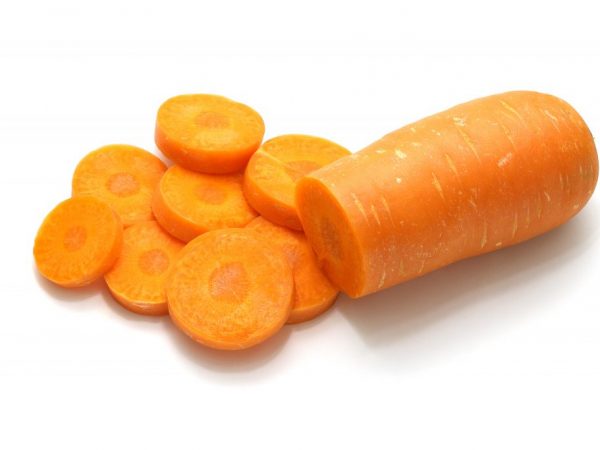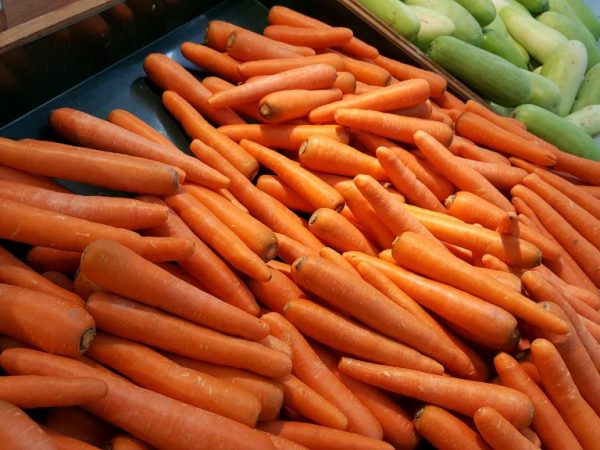Moscow winter carrots
Winter Moscow carrot belongs to mid-season high-yielding varieties. Studying the characteristics of the Moscow winter variety and the rules for its cultivation allows you to provide care for the vegetable and get a good harvest.

Moscow winter carrots
Characteristic
Moscow winter carrot A 515 is sown before winter. With winter crops, the culture is suitable for beam harvesting of products. A good harvest is obtained when sown in April-May. According to its characteristics, the variety is better than others intended for fresh consumption in winter, it is well stored.
Description of the variety
Moscow winter is universal. The period from germination to ripening is 70-100 days. This is a high-yield variety - up to 5-7 kg / m².
Description of fruits
Root crops have an elongated conical shape, blunt-pointed, grow up to 15-18 cm in length, weigh 100-170 g. According to the description of Moscow winter carrots, the orange fruit has a smooth surface, has a juicy pulp with a pleasant smell. It has a small and round, regular core.
Root crops are characterized by excellent taste. Sugar content - 7.6-8%, carotene - 10-12 mg.
Growing
Moscow winter is grown practically throughout Russia. Cold resistance allows planting crops in the northern regions.
Disembarkation
The landing is carried out in areas illuminated by the sun. In the shade, the yield decreases, the taste of root crops deteriorates.
They follow the rules of crop rotation - the order of growing vegetables in a certain area.
It is forbidden to grow Moscow winter in one garden bed after parsley, dill, parsnip and celery.
Planting a variety is allowed after:
- tomatoes;
- Luke;
- cucumbers;
- potatoes;
- cabbage;
- garlic.
Seed planting dates
Seeds of Moscow carrots are planted in the ground from April 20. Planting is best done at a temperature of 12 ° C-13 ° C.
Seed preparation and sowing

Excellent root vegetable
Germination of carrot seeds lasts for 3 years. Before sowing, they are sorted and disinfected. Their feature is slow germination. Weeds germinate faster.
To preserve the beds during weeding, the following methods are used:
- carrot seeds are mixed with washed and dried sand - the row is clearly visible during weeding;
- seeds are mixed with early crops: lettuce and radishes - their germination will be shown by the planting site;
- the seeds are glued with starch paste on narrow strips of toilet paper - the planting is clearly visible.
Seeds are laid in moist furrows to a depth of 2 cm, covered with earth or a peat-sand mixture from above, covered with foil.
The film retains moisture, protects against insects and raises the temperature of the soil, after germination it is removed.
Care
In the process of growing a crop, the thinning of the beds plays an important role. The first thinning is carried out at the moment of opening the first pair of leaves. After that, a row of plants remains at a distance of 3 cm from each other.
Thinning is repeated after the formation of the second pair of leaves, weak plants are removed, the distance between the remaining ones should be 6 cm. Thinning is carried out after evening watering without the risk of pests. After watering, a bed with Moscow winter carrots is loosened. Peat mulching helps to avoid the appearance of a crust in the garden.
Fertilizer
Top dressing of Moscow carrots is carried out twice:
- After the 1st thinning of the shoots. In 1 liter of infusion of weeds, add 5 liters of water, add 10 g of potash fertilizers. If complex fertilizers were added during sowing, top dressing is not carried out.
- After the 2nd thinning. 30 g of potash fertilizers are diluted in 12 liters of water.
Watering
In the process of carrot development, greens are formed first, followed by a root crop. The plant in the early stages needs abundant watering: 4 liters of water per sq. m. The liquid is introduced every 2-3 days.
The first 2 months, watering is gradually increased, and during the period of growth of root crops, it is reduced to once a week. In this case, the water consumption should be 9-10 liters per sq. m. Waterlogging of the soil leads to cracking of carrots.
Diseases and pests
The main pests of Moscow carrots:
- umbellate leaf flies;
- carrot fly;
- cabbage butterfly.
Carrots are slightly susceptible to diseases, but they manifest themselves:
- Alternaria is a fungal disease that manifests itself in the form of mold and stains.
- Fomoz is a disease that occurs under the influence of the fungus Foma Rostrup. In the area where the disease is detected, carrots are re-planted only after 4 years.
Treatment of diseases
To cope with fungal diseases, fertilizing with potassium and treating the beds with a 1% solution of Bordeaux liquid help.
Getting rid of pests
To combat the umbelliferae and carrot fly, the seeds are planted as early as possible and covered with a non-woven material - lutrasil. The drugs Intavir and Actellik help to fight the carrot fly.
When cabbage appears, the crops are covered.
Conclusion
Moscow winter carrot A 515 has excellent taste. Proper care and compliance with the rules for growing the Moscow winter carrot variety will allow you to get a good harvest of root crops.


